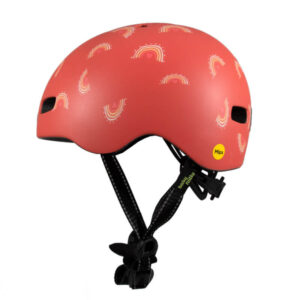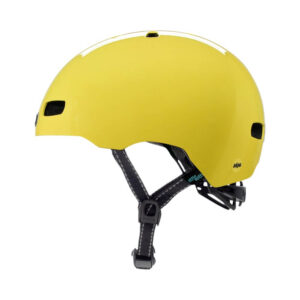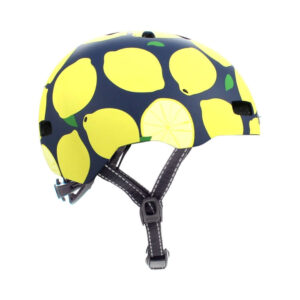KIDS HELMETS
BABY, TODDLER & ADULTS HELMETS
BUY HELMETS FOR KIDS AUSTRALIA
Toddlers usually injure themselves while crawling or cycling. So, it’s necessary to think about their protection. You can look for bike safety accessories like helmets for kids, toddlers, and babies in Australia from XCHANGE SPORTS, with a collection of ideal bike helmets for every size & age. Being the best kids bikes sellers, we are proud to offer lightweight and adjustable youth helmets (certified CPSIA compliant).
-
Baby Helmets, Kids Helmets, Nutcase Helmets
Rated 0 out of 5$119.95Original price was: $119.95.$109.95Current price is: $109.95. inc GST View Product -
Kids Helmets, Baby Helmets, Globber Helmets, Toddler & Youth Helmets
Rated 0 out of 5$75.00 – $79.00 inc GST View Product -
Baby Helmets, Kids Helmets, Nutcase Helmets
Rated 0 out of 5$119.95Original price was: $119.95.$109.95Current price is: $109.95. inc GST View Product -
Baby Helmets, Kids Helmets, Nutcase Helmets
Rated 0 out of 5$119.99Original price was: $119.99.$109.95Current price is: $109.95. inc GST View Product -
Baby Helmets, Kids Helmets, Nutcase Helmets
Rated 0 out of 5$119.99Original price was: $119.99.$109.95Current price is: $109.95. inc GST View Product -
Baby Helmets, Kids Helmets, Nutcase Helmets
Rated 0 out of 5$119.95Original price was: $119.95.$109.95Current price is: $109.95. inc GST View Product -
Baby Helmets, Kids Helmets, Nutcase Helmets
Rated 0 out of 5$119.99Original price was: $119.99.$109.95Current price is: $109.95. inc GST View Product -
Baby Helmets, Kids Helmets, Nutcase Helmets
Rated 0 out of 5$119.99Original price was: $119.99.$109.95Current price is: $109.95. inc GST View Product
-
Toddler & Youth Helmets, Kids Helmets, Nutcase Helmets
Rated 0 out of 5$139.99Original price was: $139.99.$119.95Current price is: $119.95. inc GST View Product -
Toddler & Youth Helmets, Kids Helmets, Nutcase Helmets
Rated 0 out of 5$139.99Original price was: $139.99.$119.95Current price is: $119.95. inc GST View Product -
Toddler & Youth Helmets, Kids Helmets, Nutcase Helmets
Rated 0 out of 5$139.99Original price was: $139.99.$119.95Current price is: $119.95. inc GST View Product -
Toddler & Youth Helmets, Kids Helmets, Nutcase Helmets
Rated 0 out of 5$139.99Original price was: $139.99.$119.95Current price is: $119.95. inc GST View Product -
Toddler & Youth Helmets, Kids Helmets, Nutcase Helmets
Rated 0 out of 5$139.99Original price was: $139.99.$119.95Current price is: $119.95. inc GST View Product -
Kids Helmets, Baby Helmets, Globber Helmets, Toddler & Youth Helmets
Rated 0 out of 5$75.00 – $79.00 inc GST View Product -
Toddler & Youth Helmets, Kids Helmets, Nutcase Helmets
Rated 0 out of 5$139.99Original price was: $139.99.$119.95Current price is: $119.95. inc GST View Product -
Skate & Scooter Helmets, Hornit Helmets, Kids Helmets, Toddler & Youth Helmets
Rated 0 out of 5$69.95 inc GST View Product -
Skate & Scooter Helmets, Hornit Helmets, Kids Helmets, Toddler & Youth Helmets
Rated 0 out of 5$69.95 inc GST View Product -
Skate & Scooter Helmets, Hornit Helmets, Kids Helmets, Toddler & Youth Helmets
Rated 0 out of 5$69.95 inc GST View Product -
Toddler & Youth Helmets, Kids Helmets, Nutcase Helmets
Rated 0 out of 5$109.95 – $119.95 inc GST View Product -
Toddler & Youth Helmets, Kids Helmets, Nutcase Helmets
Rated 0 out of 5$139.99Original price was: $139.99.$119.95Current price is: $119.95. inc GST View Product -
Toddler & Youth Helmets, Kids Helmets, Nutcase Helmets
Rated 0 out of 5$139.99Original price was: $139.99.$119.95Current price is: $119.95. inc GST View Product -
Toddler & Youth Helmets, Kids Helmets, Nutcase Helmets
Rated 0 out of 5$139.99Original price was: $139.99.$119.95Current price is: $119.95. inc GST View Product -
Toddler & Youth Helmets, Kids Helmets, Nutcase Helmets
Rated 0 out of 5$139.99Original price was: $139.99.$119.95Current price is: $119.95. inc GST View Product
-
Adult Helmets, Kids Helmets, Nutcase Helmets
Rated 0 out of 5$159.99Original price was: $159.99.$129.95Current price is: $129.95. inc GST View Product -
Adult Helmets, Kids Helmets, Nutcase Helmets
Rated 0 out of 5$159.99Original price was: $159.99.$129.95Current price is: $129.95. inc GST View Product -
Adult Helmets, Kids Helmets, Nutcase Helmets
Rated 0 out of 5$159.99Original price was: $159.99.$129.95Current price is: $129.95. inc GST View Product -
Adult Helmets, Kids Helmets, Nutcase Helmets
Rated 0 out of 5$159.99Original price was: $159.99.$129.95Current price is: $129.95. inc GST View Product -
Adult Helmets, Kids Helmets, Nutcase Helmets
Rated 0 out of 5$159.99Original price was: $159.99.$129.95Current price is: $129.95. inc GST View Product -
Adult Helmets, Kids Helmets, Nutcase Helmets
Rated 0 out of 5$159.99Original price was: $159.99.$129.95Current price is: $129.95. inc GST View Product -
Adult Helmets, Kids Helmets, Nutcase Helmets
Rated 0 out of 5$159.99Original price was: $159.99.$129.95Current price is: $129.95. inc GST View Product -
Adult Helmets, Kids Helmets, Nutcase Helmets
Rated 0 out of 5$159.99Original price was: $159.99.$129.95Current price is: $129.95. inc GST View Product -
Adult Helmets, Kids Helmets, Nutcase Helmets
Rated 0 out of 5$159.99Original price was: $159.99.$129.95Current price is: $129.95. inc GST View Product -
Adult Helmets, Kids Helmets, Nutcase Helmets
Rated 0 out of 5$159.99Original price was: $159.99.$129.95Current price is: $129.95. inc GST View Product -
Adult Helmets, Kids Helmets, Nutcase Helmets
Rated 0 out of 5$159.99Original price was: $159.99.$129.95Current price is: $129.95. inc GST View Product -
Adult Helmets, Kids Helmets, Nutcase Helmets
Rated 0 out of 5$159.99Original price was: $159.99.$129.95Current price is: $129.95. inc GST View Product -
Adult Helmets, Kids Helmets, Nutcase Helmets
Rated 0 out of 5$159.95Original price was: $159.95.$129.95Current price is: $129.95. inc GST View Product -
Adult Helmets, Kids Helmets, Nutcase Helmets
Rated 0 out of 5$159.99Original price was: $159.99.$129.95Current price is: $129.95. inc GST View Product -
Adult Helmets, Kids Helmets, Nutcase Helmets
Rated 0 out of 5$159.95Original price was: $159.95.$129.95Current price is: $129.95. inc GST View Product -
Adult Helmets, Kids Helmets, Nutcase Helmets
Rated 0 out of 5$159.95Original price was: $159.95.$129.95Current price is: $129.95. inc GST View Product -
Adult Helmets, Kids Helmets, Nutcase Helmets
Rated 0 out of 5$159.95Original price was: $159.95.$129.95Current price is: $129.95. inc GST View Product
-
Skate & Scooter Helmets, Hornit Helmets, Kids Helmets, Toddler & Youth Helmets
Rated 0 out of 5$69.95 inc GST View Product -
Skate & Scooter Helmets, Hornit Helmets, Kids Helmets, Toddler & Youth Helmets
Rated 0 out of 5$69.95 inc GST View Product -
Skate & Scooter Helmets, Hornit Helmets, Kids Helmets, Toddler & Youth Helmets
Rated 0 out of 5$69.95 inc GST View Product
GOT QUESTIONS ABOUT KIDS HELMETS?
Children should always wear a helmet when riding a bicycle. They should be fitted with a full face shield and be able to see clearly.
Any type of helmet is safe for kids to wear. But, we recommend using a helmet with a chin strap, as it provides the most secure fit and keeps the helmet from slipping off. Also, avoid helmets with visors, as they increase the risk of accidents, especially if your kids have glasses.
While both are great, soft-shell helmets are more flexible and offer a superior fit. Hard-shell helmets are usually more durable and come with better ventilation, but they can be difficult to fit and don’t allow for as much flexibility.



















































































